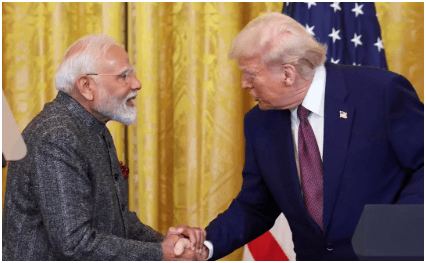Modi-Trump Meeting: Indian Prime Minister Narendra Modi met with U.S. President Donald Trump in Washington to discuss military and trade collaboration.
Indian Prime Minister Narendra Modi met with U.S. President Donald Trump in Washington, a high-profile engagement aimed at strengthening the strategic partnership between the two nations. The meeting marked a pivotal moment in U.S.-India relations, underscoring both leaders’ commitment to deepening collaboration on defense, trade, and global security matters. The discussions held at the White House spanned various topics, with particular focus on the potential sale of advanced F-35 fighter jets to India and ambitious plans to double bilateral trade to $500 billion by 2030.
The atmosphere during the meeting was one of optimism and mutual respect, with both leaders emphasizing the shared values and democratic principles that underpin the U.S.-India relationship. President Trump expressed his admiration for India’s economic growth under Modi’s leadership, noting that the country had emerged as a significant global player in recent years. Modi, in turn, highlighted the importance of the United States as a trusted partner in India’s development journey and expressed gratitude for the growing bilateral cooperation across multiple sectors.
One of the key topics on the agenda was the potential sale of F-35 fighter jets to India. This move, if finalized, would represent a significant boost to India’s defense capabilities and signal deeper military ties between the two nations. The F-35, a fifth-generation stealth aircraft known for its advanced technology and versatility, is considered one of the most formidable fighter jets in the world.
For India, acquiring these jets would not only enhance its air superiority but also serve as a deterrent amid rising regional security challenges. Discussions on the sale were reportedly positive, with both leaders instructing their respective defense teams to expedite negotiations and finalize the terms. India’s potential induction into the elite club of F-35 operators would also mark a major shift in its defense procurement strategy, traditionally reliant on Russian and indigenous equipment.
The leaders also discussed expanding joint military exercises and defense technology sharing, with an eye on strengthening interoperability between the armed forces of both nations. In recent years, U.S.-India defense cooperation has witnessed remarkable progress, including the signing of foundational agreements such as the Communications Compatibility and Security Agreement (COMCASA) and the Logistics Exchange Memorandum of Agreement (LEMOA). These agreements have paved the way for closer collaboration on intelligence sharing, logistics support, and joint military operations.
On the economic front, both Modi and Trump expressed their determination to double bilateral trade to $500 billion by 2030. While ambitious, this goal reflects the growing economic ties between the two countries and the potential for further growth in sectors such as technology, energy, pharmaceuticals, and manufacturing. The leaders acknowledged the challenges posed by trade imbalances and tariffs but stressed the need for constructive dialogue and mutual concessions to achieve the desired trade expansion.
India’s burgeoning tech sector featured prominently in the discussions, with both sides exploring opportunities for greater collaboration in areas such as artificial intelligence, cybersecurity, and digital innovation. American tech giants have long viewed India as a key market for growth, while Indian firms continue to expand their presence in the U.S., contributing to job creation and technological advancement. Modi highlighted the Indian government’s initiatives to foster a digital economy, including its focus on startups and innovation, and invited American companies to invest in India’s digital transformation.
Energy cooperation was another important aspect of the talks. The U.S. has become a major supplier of crude oil and liquefied natural gas to India, helping to diversify the country’s energy imports and reduce its reliance on Middle Eastern sources. Both leaders expressed their intent to further strengthen energy trade and collaborate on clean energy initiatives, including solar and wind power. Given India’s ambitious renewable energy targets and the U.S.’s advancements in clean energy technologies, this partnership holds significant potential for mutual benefit.
Addressing regional and global security concerns, Modi and Trump reaffirmed their shared commitment to a free, open, and rules-based Indo-Pacific region. They emphasized the importance of upholding international law and ensuring freedom of navigation in the region’s vital sea lanes. Both leaders expressed concern over China’s growing assertiveness in the South China Sea and the need for enhanced cooperation among like-minded nations to promote regional stability and security.
The two leaders also discussed counterterrorism efforts and the ongoing threat posed by extremist groups. Modi commended the U.S. for its decisive action against global terrorism and reiterated India’s zero-tolerance stance on terrorism in all its forms. Both sides agreed to enhance intelligence sharing and operational coordination to thwart potential terrorist activities and protect their citizens.
In addition to defense and trade, human connections between the two nations received attention. With millions of Indian-Americans residing in the U.S., the diaspora serves as a vital bridge between the two countries. Modi acknowledged the contributions of the Indian-American community to American society and expressed his gratitude for their role in strengthening U.S.-India ties. Trump, in turn, praised the community’s achievements and reaffirmed his administration’s support for promoting cultural and educational exchanges.
